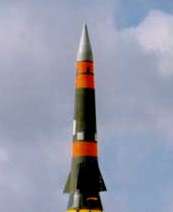Maneuverable reentry vehicle
The Maneuverable Reentry Vehicle (abbreviated MARV or MaRV) is a type of ballistic missile whose warhead is capable of autonomously tracking ground targets. It often requires some terminal active homing guidance (like Pershing II active radar homing) to make sure the missile does not miss the target, because of the frequent trajectory shifts. Refer to atmospheric reentry.

Advanced Maneuverable Reentry Vehicle

Advanced Maneuverable Reentry Vehicle (AMaRV) was a prototype MARV built by McDonnell-Douglas Corp. Four AMaRVs were made and represented a significant leap in Reentry Vehicle sophistication. Three of the AMaRVs were launched by Minuteman-1 ICBMs on 20 December 1979, 8 October 1980 and 4 October 1981. AMaRV had an entry mass of approximately 470 kg, a nose radius of 2.34 cm, a forward frustum half-angle of 10.4°, an inter-frustum radius of 14.6 cm, aft frustum half angle of 6°, and an axial length of 2.079 meters. No accurate diagram or picture of AMaRV has ever appeared in the open literature. However, a schematic sketch of an AMaRV-like vehicle along with trajectory plots showing hairpin turns has been published.[1]
AMaRV's attitude was controlled through a split body flap (also called a "split-windward flap") along with two yaw flaps mounted on the vehicle's sides. Hydraulic actuation was used for controlling the flaps. AMaRV was guided by a fully autonomous navigation system designed for evading anti-ballistic missile (ABM) interception.
MARV-capable missiles
- Agni-II (active)
- Emad (active)
- Hyunmoo-2C (active)
- R-27K (cancelled)
- Pershing II (retired)
See also
References
- Regan, Frank J. and Anadakrishnan, Satya M. (1993), Dynamics of Atmospheric Re-Entry, AIAA Education Series, American Institute of Aeronautics and Astronautics, Inc., New York, ISBN 1-56347-048-9.
- https://missilethreat.csis.org/missile/kn-18-marv-scud-variant/
- https://missiledefenseadvocacy.org/missile-threat-and-proliferation/todays-missile-threat/north-korea/kn-18/